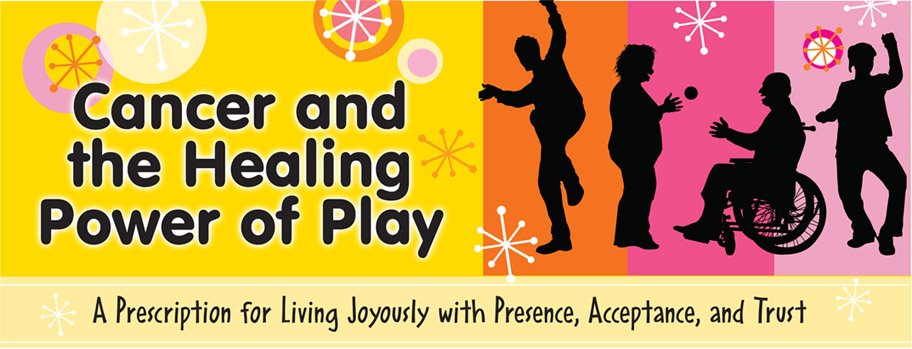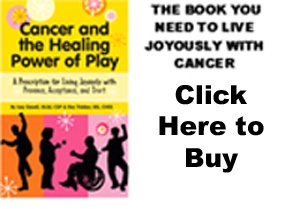My colleague and friend, Susan Trivers, has created a step-by-step How To Guide for you to tell stories. Stories have magical power to touch people's hearts, inspire them, make them laugh, and create new relationships and bonds that increase everyone's level of joy.
Take a few minutes and follow Susan's Guide to Healing Stories. When you finish crafting your stories, you will have great fun playing the games in "Cancer and the Healing Power of Play."
It's your turn to have fun now! Go for it!
Every Person’s Guide to Telling Stories of Healing and Renewal
By Susan Trivers
“Lily was a bare 85 pounds, with shriveled limbs, sunken cheeks and a voice that had been robbed of its projection ability by aggressive Parkinson’s disease. I asked her if there was someone she would like to write a letter to because she had learned to communicate by pointing to letters printed on a sheet of paper.
She dictated a letter to her girlhood friend: “Dear Selma, I am holding my own.”
This is my story about my mother. It encompasses the years of her illness and also tells the listener that she was not her disease. She had held her own in the face of many obstacles and challenges throughout her life and in her final days, she was still telling her best friend that she wasn’t giving in. She always faced her obstacles with dignity and quiet confidence, and she did the same in that precious moment.
She remained Lily, mentally strong and optimistic, till the very end. When I tell my story about my mother, I am also telling her story for her.
As I face my own challenges in health and in sickness, I hear my mother’s voice and I remember to “hold my own.”
What’s Your Story?
What story do you want to leave as a legacy? How do you encapsulate your years of ups and downs and struggles and triumphs in a few sentences? More importantly, do you want your story to be one about your struggles or about your outcomes?
You will feel peaceful and joyful when you write your life’s story as one of outcomes. You faced crises, you did what you had to do to overcome the obstacles, and you came to a resolution. These three elements are the essence of a story: crisis, obstacles and the efforts to overcome them, and the resolution.
How you craft your story is your choice. This short book shows you that crafting your story as one about outcomes is an act of love for yourself first and for others who will hear your story.
Let’s spend a moment talking about what a story is NOT:
It is not a news report. That is, take off your reporter’s hat and forget the “who, what, where, when, & how” of good news reporting. You will have lots of details that fit those categories. I’m sure you know them by heart and have deep feelings about the details of your illness or those of the person for whom you are providing care.
It’s not easy to get out of the reporter mindset when your days are filled with schedules of appointments, medications, and therapies. You spend hours and days on the “who, what, where, when, & how.” These may be the only things you can see at times. It is hard to put them on the back burner.
What IS a story?
· A story is about challenges faced and outcomes reached.
· A story is about your feelings including fear, mystery, joy, anger, disappointment, determination, persistence, rejection, and acceptance.
· A story is about shaping others understanding about you: your values and who you are as an individual.
If you are a caregiver you can craft a story about your challenges, outcomes and feelings or about the character and legacy of the person you are caring for.
Crafting your story
I use the word “crafting” instead of writing or telling because I want you to first think that a story is a work of art. It is the same as if you painted a picture, made a photograph, molded a sculpture of clay or chiseled one out of wood or stone.
Think about physical art. The artist has to select the elements that go into the work: which colors, which details, what size, what kind of mood?
You will do the same when you craft your story.
Details tend to be the biggest nemesis. Your head is filled with them and they seem to be what the story is all about. I believe that a story is more compelling when you select only a few details.
Step 1:
· Write a list of the details that come to your mind right now. This is not a test—just a stream of consciousness moment. Write down whatever you can in 60 seconds:
· Now write down a list of challenges. These can be big (surviving cancer) or smaller (getting to the doctor’s office). Your mind is full of these as well. Give yourself 60 seconds to make a quick list of those at the top of your mind.
· The next step is to write down how you overcome your challenges. Take 60 seconds to write down what actions you take to overcome the challenges.
· What are your feelings about these challenges and the way you act to overcome them? Do not hesitate to write down the real, accurate truth about your feelings. And be sure to allow yourself a range of feelings from anger and frustration to contentment and joy. Use the most evocative language you can to describe your feelings.
Step 2:
Now pull one or two of the most powerful items from each of the lists you made in Step 1.
Details:
Challenges:
How you overcome your challenges:
Feelings:
Step 3:
· Use great writing tools such as analogies and metaphors. Maybe tubes and beeps remind you of something else from another setting and time.
· Ask the listener to participate: “Imagine if you had to… What would you do?” Then give a brief line or two about how you or the person handled the situation.
· Create an emotion: “The doctors left the room in a hurry. They were whispering urgently. What was happening?”
On the rest of this page and on other pages if needed, jot down the elements of your story in different sequences. Read your drafts out loud so you can hear what the story will sound like when you tell it. Finally settle on one version and write it out clearly and cleanly.
Build your story here:
Complete your story here:
Think of the story you craft as part of a conversation. When you tell your story your goal is to sound like yourself, polished.
Most important are your feelings when you tell your story. Try to live in the moment and experience again the warmth of love of the person at the heart of the story.

